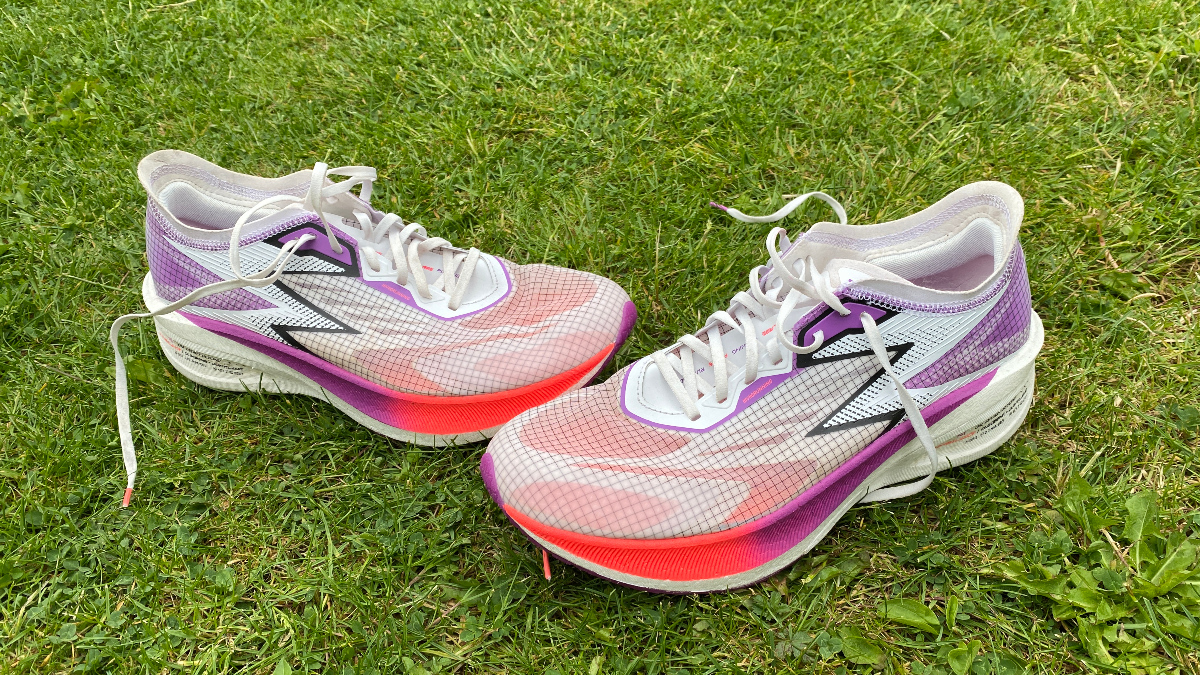Our Verdict
It doesn’t match the performance of the best carbon racing shoes but the 361° Flame offers good value as a fast trainer and racer.
For
- Fast, efficient ride
- Cheaper than most carbon shoes
- Gripped well in the wet
Against
- Heavier than other carbon racers
- Not as bouncy as the best shoes
- Hard to get hold of
You can trust Coach
All the best carbon-plate running shoes are, in some way, indebted to the Nike Vaporfly and take cues from the archetype. However, in the case of the 361° Flame, the similarity to the design and geometry of the Vaporfly is, at first glance, striking.
Looks are one thing. The bigger question is whether the performance of the Flame, which costs $160 in the US and £155 in the UK, can get close to matching the latest Nike (the Nike Vaporfly NEXT% 2) and other top carbon shoes like the Adidas Adios Pro 2 and Asics Metaspeed Sky. If so, the Flame could be one of the best running shoes available, offering top-class performance at a reasonable price.
361° Flame: Price And Availability
The 361° Flame launched in 2021 but has been hard to get hold of since. The shoe is now in stock on the US website of 361° and costs $160. In Europe you can get it on the 361° European website for €179.99. The shoe costs £155 in the UK and is available from select retailers.
While most carbon plate super-shoes cost £200-plus, the Flame is priced more in line with training partner shoes like the Saucony Endorphin Speed 2.
Design And Fit
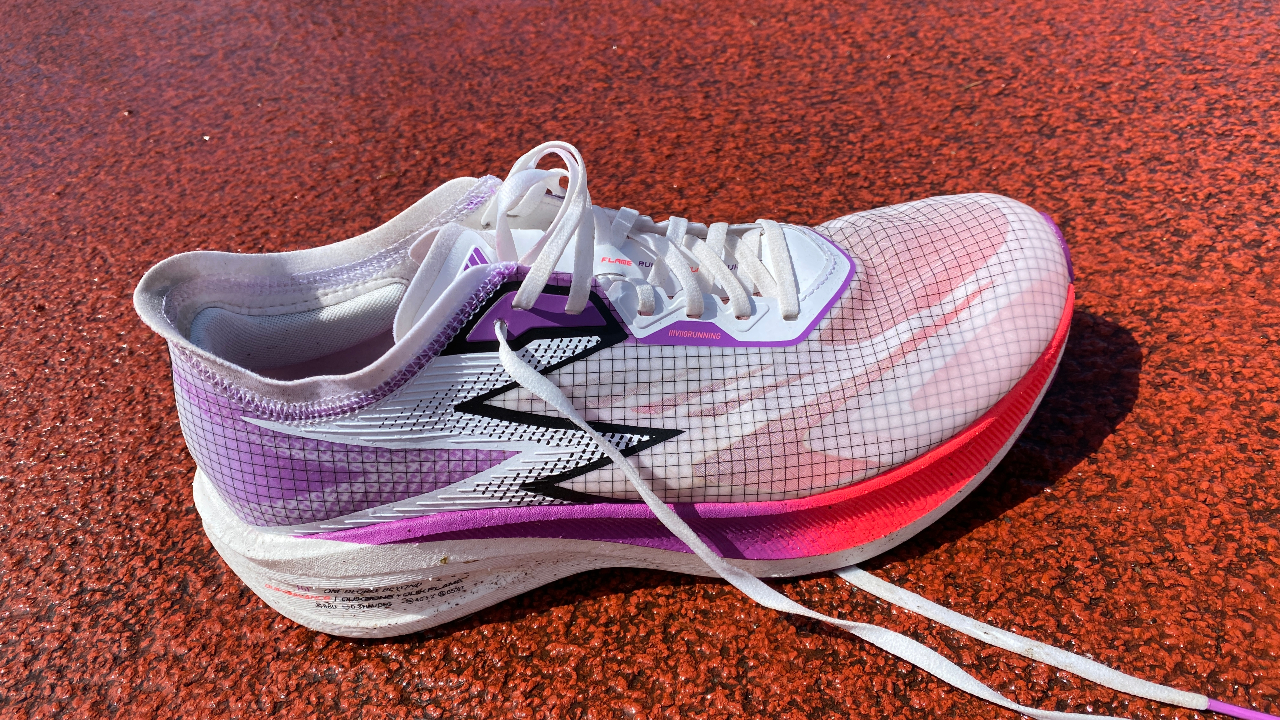
With all carbon plate super-shoes, the magic is in the midsole. This is where you generally find a high stack of soft and bouncy foam combined with a full-length carbon plate (or equivalent, such as Adidas’s EnergyRods).
The 361° Flame uses a polyurethane foam called QU!KFLAME in the midsole, which is not as soft and springy as PEBA foams like Nike’s ZoomX or New Balance’s FuelCell material. However, it does feel responsive underfoot, and despite a relatively low stack of 32mm at the heel and 24mm at the forefoot (compared with the 40mm limit many shoes are close to), the midsole is comfortable enough not to feel harsh because of the plate.
Continuing the theme of using ALL CAPS and throwing in rogue punctuation, the plate is called QU!KBONE and is visible through a substantial cut-out in the centre of the outsole, a design element which is there to reduce the weight of the shoe.
The outsole follows in the path of most racing shoes by having minimal rubber, with a thin layer covering the forefoot and then two strips at the heel. Despite this the shoe gripped well for me, even in wet conditions on the road.
The upper is a thin monomesh material that reminded me of the Vaporweave upper on the original Nike Vaporfly NEXT%. There is minimal padding around the heel, but I didn’t have any problems with slippage in my normal size, and there was plenty of room in the toe box.
At 250g in a UK 9 the 361° Flame is far from heavy – though it is heavier than most carbon-plate racing shoes, which mostly weigh 200g-235g in my size.
How I Tested This Shoe
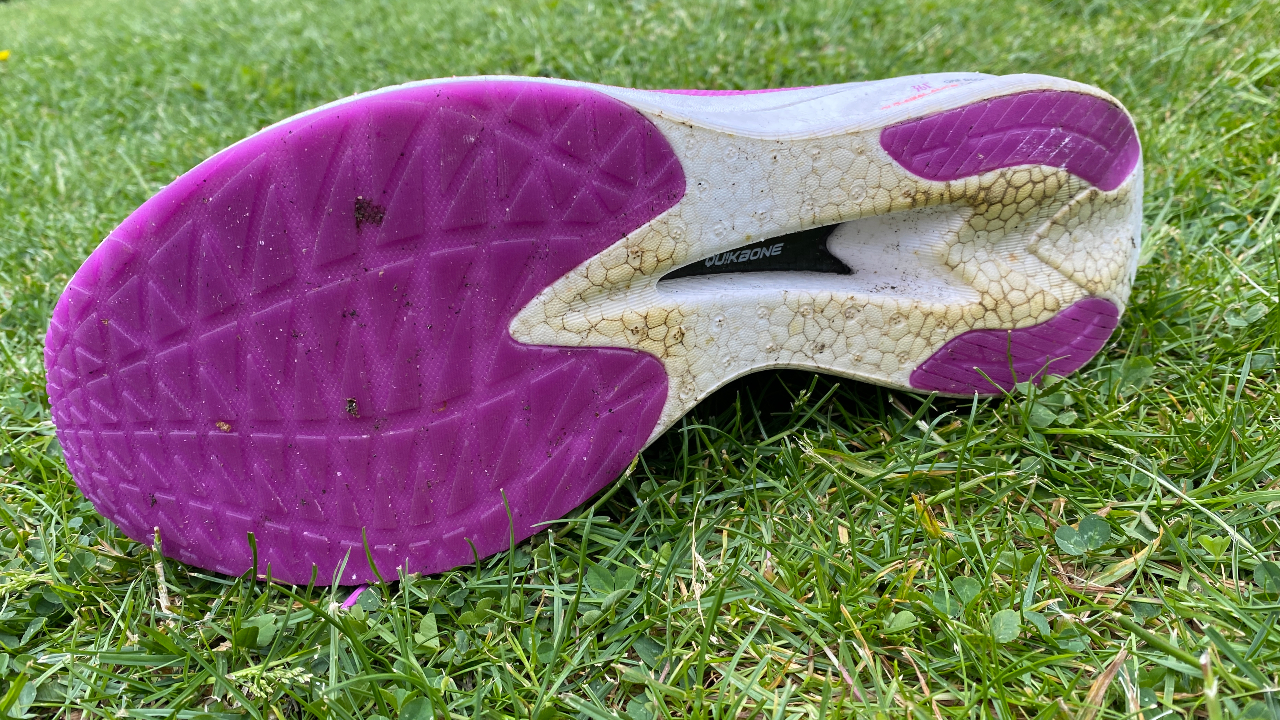
I’ve run just over 50km in the 361° Flame. This has been mostly fast running, including two hard workouts on the road and a track session, plus one fairly easy run to see how it fared as a daily trainer.
Running Performance
The 361° Flame doesn’t feel fantastic or natural when running at easy paces, but every time I have stepped up a gear in the shoe it has been a pleasant surprise. Since the foam is not squishy and springy like on many super-shoes I wasn’t expecting a great deal from the Flame – there are other shoes that have combined a carbon plate with mediocre midsole foams with uninspiring results – but the QU!KFLAME foam delivers a high level of performance.
My first run with the shoe was a tough workout running two sets of 3km at 3min 20sec/km, followed by five hill reps. It’s a long session that wears me down, but the Flame matched the best super-shoes in helping me to hold a fast pace even as I started to tire.
The geometry of the shoe means it feels like it is tipping you forwards with each stride, an effect that is especially noticeable on downhills. It reminded me of the Vaporfly in that regard, even with the firmer midsole on the Flame.
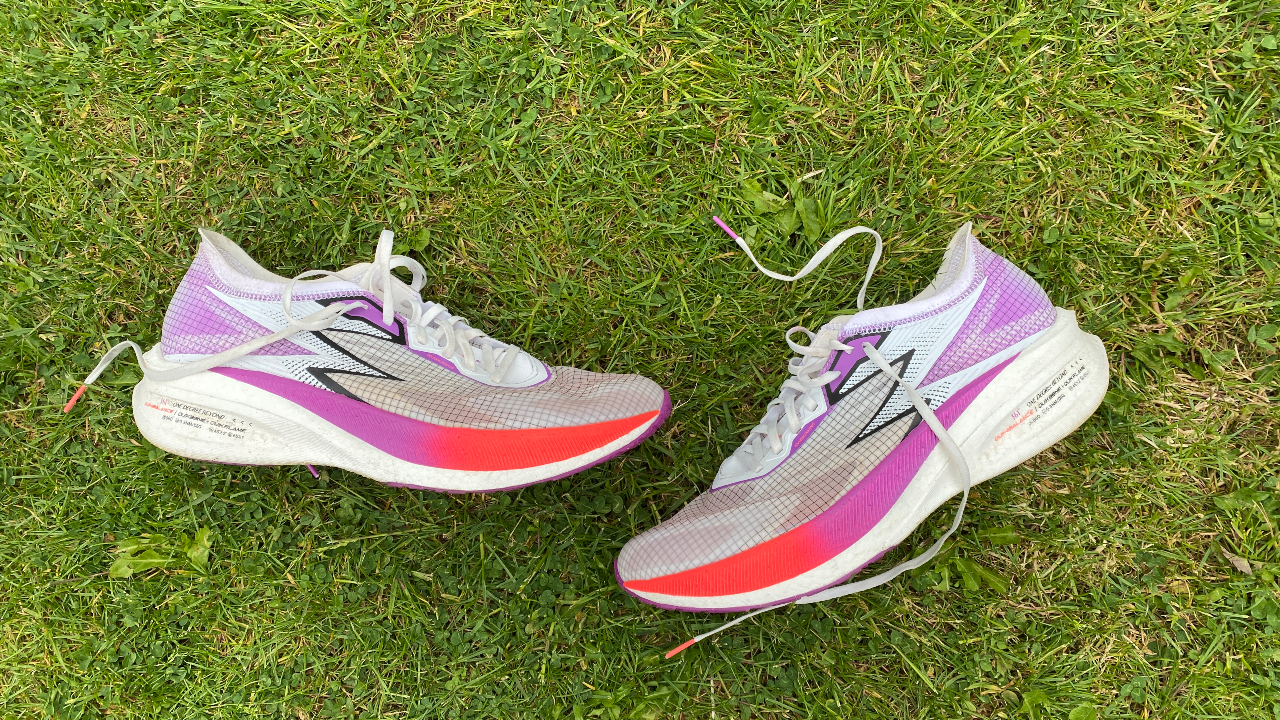
Despite not being the lightest of shoes the Flame also feels good at faster paces. I did a track workout that included sets of 400m reps in 72 seconds and the weight wasn’t noticeable. That workout was done in a delightful mix of apocalyptic hail and thunderous rain, and the Flame gripped reliably on the flooded track.
I was also impressed by how the shoe felt when running fast on tired legs. A favourite workout of my coach is to do a hard 5K, take a short break, then run another 5K around two minutes slower than the first one. I used the Flame for the second of those 5Ks after running 16min in a local parkrun (in the excellent Adidas Takumi Sen 8) and found the slower pace came easily and the shoe felt comfortable.
The Flame has impressed me every time I’ve run fast in it and while it doesn’t match the performance of the best super-shoes, which are lighter and springier, it is a terrific option at $160/£155 – either to use as a trainer/racer or as your fast training shoe in partnership with something like the Vaporfly. It’s a good training partner for the Vaporfly since it has a similar set-up but a firmer, more stable platform that will probably prove more durable.
Is The 361° Flame Worth It?
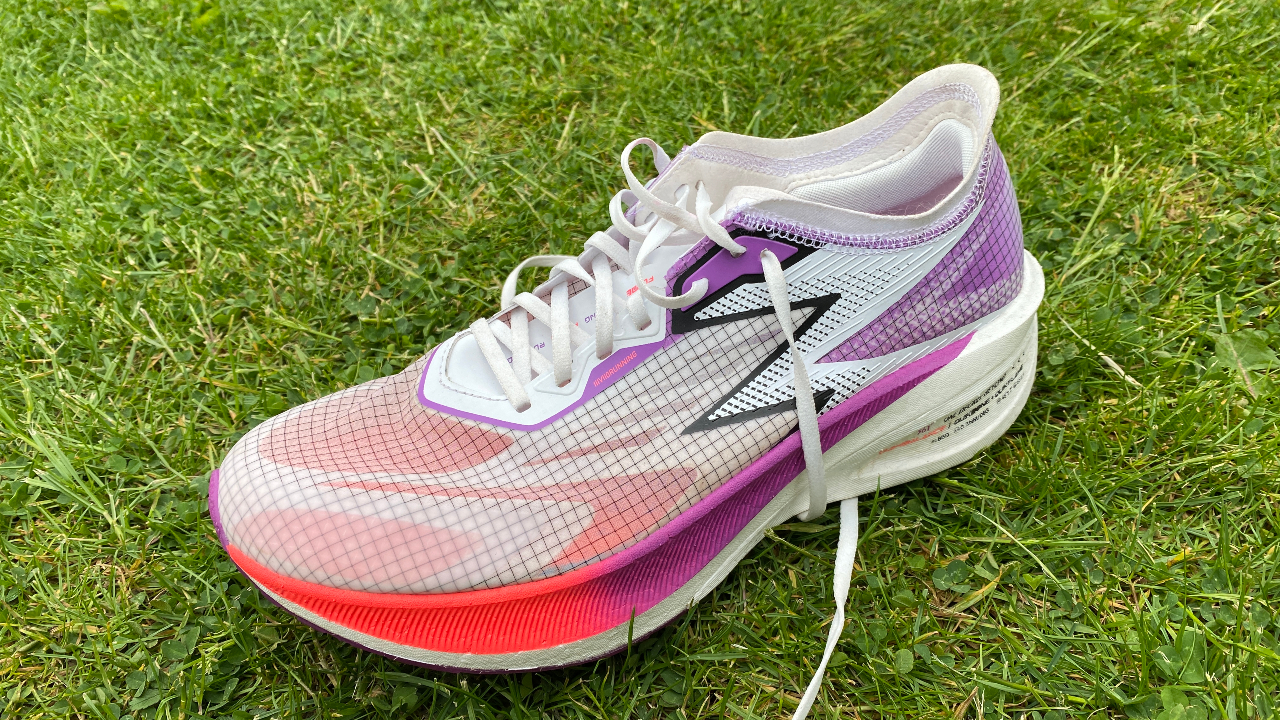
If you’re just looking for the best racing shoe you can get then it’s worth spending more on something like the Vaporfly. There are also more impressive super-shoes available for a little extra, like the Adios Pro 2 or Puma Deviate Nitro Elite.
However, at its price it’s worth investigating the Flame. The main rival would be the Saucony Endorphin Speed 2, which is a terrific all-rounder that is better for easy runs while being lighter than the Flame and similarly fast. I’d give the edge to the Speed 2 myself as a more versatile shoe, but the Flame might have the edge for pure pace.
Before making your decision, you also need to bear in mind that the Flame has been hard to get hold of since its launch, and 361° is now trailing the launch of a new carbon shoe called the Hurricane. So it may be wise to keep your powder dry and wait on that if you’re looking for a plated trainer.

Nick Harris-Fry is a journalist who has been covering health and fitness since 2015. Nick is an avid runner, covering 70-110km a week, which gives him ample opportunity to test a wide range of running shoes and running gear. He is also the chief tester for fitness trackers and running watches, treadmills and exercise bikes, and workout headphones.
